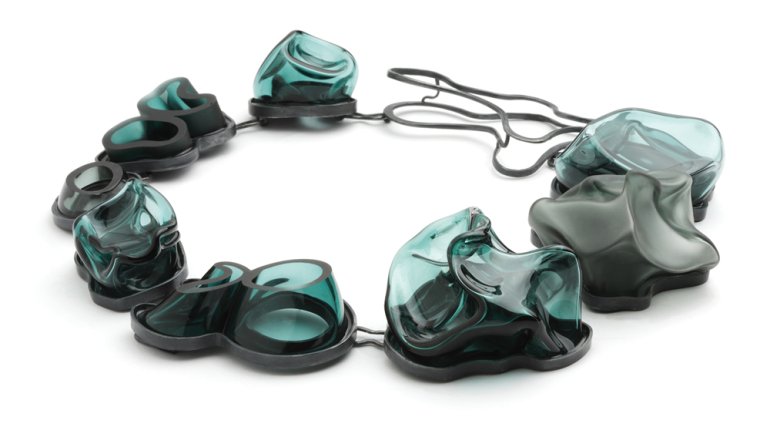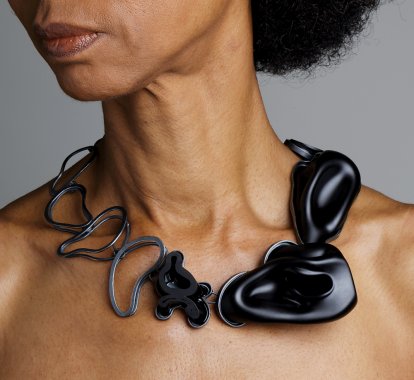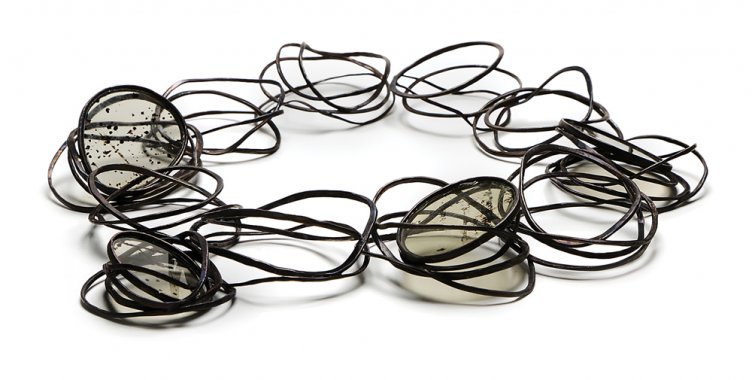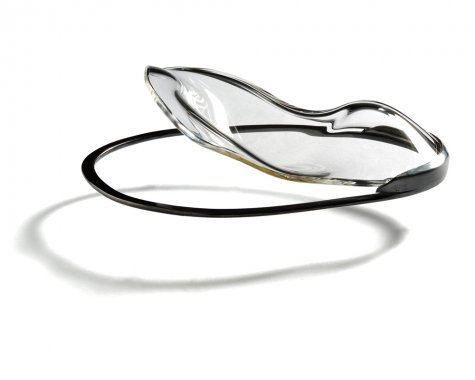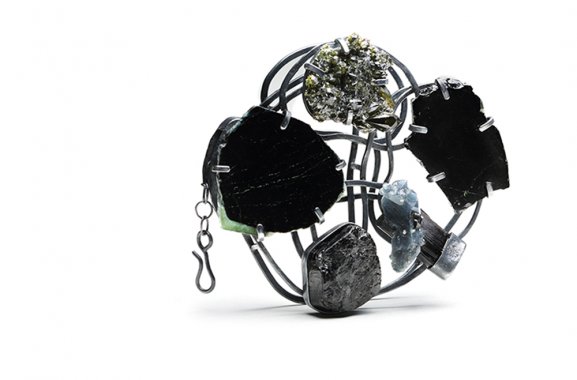Where It Takes Her
Where It Takes Her
Ask Biba Schutz what she considers the essence of her jewelry, and she has an intriguing answer. It’s not her imaginative way with materials, although she is well-known for that. Nor is it the striking statement her pieces make on the body. For her, it’s their effect on the subconscious.
“There are places to travel through in my work and places to hide,” Schutz says. “When you look, you’ll be able to see it.”
And it’s true. Her one-of-a-kind and limited-edition adornments are small sculptures, compositions of form, space, color, and texture that move us in mysterious ways. An amorphous well of mirrored glass contains and distorts the world, in the guise of a cocktail ring. A necklace of shed antler murmurs of primordial matter, origins. A brooch of glistening tourmaline chunks, caught in flowing currents of silver, reverberates with the artist’s memories of a trip to Lake Garda in Italy. Most evocative, perhaps, are her pieces made of geometric chain links: Arranged in animated clusters, they suggest a diverse group of individuals, each unlike the other, but stronger together. In every object, the meaning is hidden or personal, and that’s the point. Schutz trusts that those who buy and wear her jewelry “get it” – or at least are willing to see where it takes them.
Her own artistic journey has been an eclectic chain of events, “a lot of things that all add up,” says Schutz, who exudes that blend of sprightly and savvy peculiar to native New Yorkers. She had an idyllic childhood in 1950s Queens. Her father was a contractor, and she remembers watching with interest as he drew up plans. “When he walked into a building, how it was made was important to him. He knocked on walls, looked at the way things were structured.” Her grandfather, who worked in the garment district, made all her winter coats; as a little girl, she’d pick out fabrics, buttons, and pocket styles. Looking back, she says, “these things were all about materiality and process.”
She earned a degree in graphic art and printmaking at American University in Washington, DC, in 1968 and began working as a graphic designer. About a year later, she saw a landmark show of women textile artists at the Museum of Modern Art, which featured groundbreakers such as Magdalena Abakanowicz, Lenore Tawney, and Sheila Hicks. “I went, ‘Oh my God, this is what I want to do,’ ” she recalls. “I just wanted to get my hands into something.”
Then a friend showed her an article about the Instituto Allende weaving program in Mexico. “She said, ‘Let’s go,’ and I said, ‘Yeah!’ ” Schutz lasted a month at the school (“I was young and floundering around”) but lingered in Mexico. “It was a really rich and exploratory time. I traveled, made creative friends, took different risks.” As the decade progressed, she lived in Boston, did freelance graphic design, and explored bookbinding, papermaking, and sculpture before settling back in New York in 1979.
In the mid-1980s, she took up jewelry, at first working exclusively in anodized aluminum. “I never trained as a jeweler. I didn’t understand tools, so I made my own.” By 1990, she’d developed her signature wire-wrapping technique and started getting adventurous with her materials, which have since encompassed blown glass, paper, leather, and raw semi-precious gemstones, often in unusual combinations.
She maintains her studio in Manhattan’s old furrier district, not far from where she lives with her husband of 35 years, photographer Ron Boszko. “I walk to and from work. That’s when I work things out. I talk to myself, resolve technical and conceptual issues. It’s like I doodle in my brain, and it’s paramount in my process.” Always, she notices shadows. “They’re really important to me, just as influential as the buildings, the space between them, the light coming through or out.” No matter the material, “shadow is how my work comes together.”
Ever a restless creative spirit, she finds herself “constantly drawn into new things. It’s important to keep myself engaged and challenged.” She did an artist residency at the Corning Museum of Glass in 2014 and lately has started working with diamonds, a type of bling that never interested her before. “There’s something to be said for getting older and looking at things in a broader context, being more comfortable with yourself,” Schutz reflects. Where she’s headed next, who knows? “It’s a novel with all these chapters. Some lead into the others, and some don’t.”


